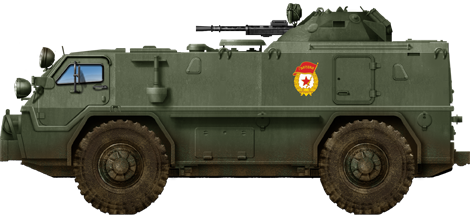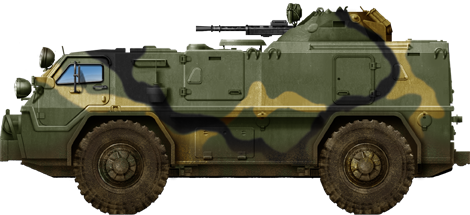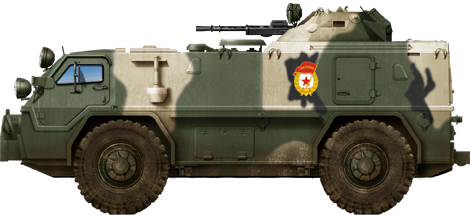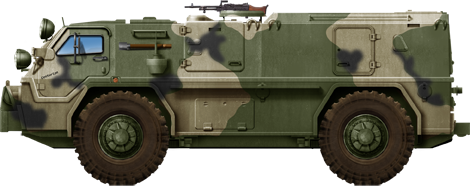The GAZ-3937 "Vodnik" is a modern armoured fighting vehicle of the Russian Army, but a rather foggy one. It seems to have been delivered only in relatively small quantities. The Vodnik (sometimes traduced as "sergeant") or GAZ-3937, and its version GAZ-39371 comes as a 4x4 Russian high-mobility multipurpose military vehicle. Designed as a possible replacement for the legacy cold war BRDM-2 in 1987-88 it was relaunehd in the 2000s as a heavy modification of the civilian GAZ-2330 "Tigr" and development restarted in 1998. It was not adopted by the Russian Armed Forces in 2005, but saw however a limited production for export, use by special forces, and had been seen in action since in Chechnya, and by Donbass separatists from 2014. So far it was also exported also to Syria and Uruguay. In the recent war it also was seen in action with Ukraine (both captured) with the basic BTR-80 turret.

The vehicle was originally developed by order of the USSR Ministry of Defense and already called "Vodnik" as a small, light APC alternative to current 8x8 vehicles. In 1988, NAMI developed an amphibious vehicle called NAMI-0281 with a completely different layout from what it became later. The powertrain was located in the rear and the cargo-passenger compartment in the middle with a side front one-seat cabion. This solution allowed maintaining trim afloat regardless of the cargo transported. NAMI-0281 was in the same veing as the BRDM-2, with an unladen weight of 2,8 ton, 9 pasengers. Neither NAMI-0281 nor extrapolated initial GAZ-3937 met requirements of the Ministry of Defense as the competition required a gross weight up to 4000 kg with air transportability by an Mi-8 helicopter. It seems the basis and concept was relau ched by the new Russian MoD, where it was based on the existing GAZ-2330 "Tigr" with heavy modifications.
The GAZ-3937 Vodnik has a standard crew of two, driver and commander seated at the front with good visibility thanks to the shutter-less bulletproof glass, with two short access doors on either side and roof hatches to stand. In the compartment right behind, the GAZ-3937 could accomodate up to eight infantrymen, accessing from rear door and also caopable of standing through roof hatches. Internal configuration could change however. The compartment is designed to provide the essentials of a wheeled APC using a 4x4 configuration, with individual seating and adequate space for personal equipment, but seemingly no mine protection.
The GAZ-3937 "Vodnik" is a modern Russian off-road vehicle, designed for fast, protected troop transport and cargo. The body is slab-sided, with an upper section sloped up, a COE configuration with a sloped nose, and back two doors. Protection is only sufficient against small arms and shrapnel, c8 mm, perhaps 14mm on the front. It was designed by TKB JSC "GAZ" and manufactured at Arzamas.
One core principle was its modular scheme with two replaceable modules placed in the welded body and interchangeable to be specific. The front module included the engine compartment and cabin, separated from by a fireproof partition. The rear module could be replaced in the field due to the quick-disassembly connection and could really be multi-functions, with the basic troop transportat, cargo carrier, specialized equipments, and mobile energy plant or tanker. The front axle of the car is driven but can be disconnected and the suspension is independent with a centralized tires inflation system as well as power steering, heating and conditioning system.
The GAZ-3937 Vodnik possessed a ring mount at the rear to house several turrets type mission-specific and user preferences specific. The base APC version esentially had by default the BTR-80 one-man turret armed with a single 14.5mm KPVT heavy machine gun, and 7.62mm PKT coaxial machine gun plus six 81mm 902V "Tucha" smoke grenade launchers mounted at its rear for active concealment. There is also a version without turret with a simple ring mount with universal plug for any machine gun, or at the countrary an IFV version with a BTR-80A like turret with 30 mm gun autocannon (seems to have been marketed but not exported yet). This BPPU turret sports a 30-mm 2A72 and PKT with gunner seating in a roof mounted chair located above the flat floor and behind the driver and commander with just two passengers. The gunner's station is basic but spacious and the turret is given a daytime sight.
The GAZ Vodnik is normally powered by the GAZ-562 (175 hp) engine but it was marketed by Arzamas as using the optional YaMZ-460 (160 hp) or HINO JO7C (165 hp) diesel. It is located at the front and transversal for a top speed of 110 km/h (68 mph) on road and cruising range of 1,000 km (620 miles). These performances are superior to previous 8x8 Soviet legacy APCs thanks to a powerful turbocharged diesel engine and efficient drivetrain. The vehicle uses a modular design with a welded front body fixed to the chassis and comprising all main drivetrain, suspensions and axles, and a rear removable module. There is a disconnectable front-wheel drive and independent torsion bar suspension as well as power steering, heating and air conditioning system. A fire fighting system is also probably optional, as NBC protection.
The GAZ 37391 is equipped with a R-173 radio station and intercom. The turbodiesel had a lot of torque as it reached 100 kph in just 18-20 seconds, at 6.5-ton load. Consumption is 20 liters per 100 km with two fuel tanks of 80 and 120 liters. Controls are somewhat similar to those on the "Volga" GAZ-31029. In trials and marketing, the vehicle demonstrated higher cross-country ability equal or superior to the GAZ-66, BTR-70 or BTR-80. It is perfectly immune to 7.62 mm Kalashnikov fire from 15 meters, having an improved armor alloy and doubled glass, both bulletproof even against 5 direct hits from a sniper rifle. The Vodnik had a sealed load-bearing hull and is fully amphibious and buoyant enoigh not only to ford but possibly float and swim at 4 kph. There are even optional waterjets with power take-off.
Russian grunts started to compare it to the American Hummer and nicknamed it the "Hammer" although it had a very different layout. The core design of the vehicle at GAZ was somehwat inspired in reaction to the motley collection of armoured vehicle sported by NATO countries making maintenance and repair a problem. GAZ worked out not only on a modular approach with a completely separate rear module and easily replacable equipment. They showed good reliabily, being reputed to have been used for over 10,000 kilometers with minimal maintenance and no problem. Other sources said parts needed to be replace after 125-130,000 km. When deployed, it had been seen as a convenient and practical vehicle for escorting columns and saw heavy action in Chechnya. The vehicle is heavily related to the civilian "Tigr" GAZ-2330 and military GAZ-2975 "Tigr" and shares many part making it affordable. Nevertheles it's a rare vehicle regardless of its popularity on video games such as "battlefield 2" and successors.
-The GAZ 39371 is the later, main production version with an advanced 2-seat forward cabin.

1P121E Radar vehicle

Up armoured variant, proposed.

Ambulance variant
Other than that, so far the vehicle only has been sported by the Russian Army, Syria, and 48 acquired by Uruguay. At least two were captured by Ukraine. Production is ellusive as it is not even listed in today's equipme,ts lists. According to Oryx, Russia lost just two of these after the 2022 invasion, captured, reused by Ukraine. However it saw action with the Separatists as well according to photos.

The vehicle was originally developed by order of the USSR Ministry of Defense and already called "Vodnik" as a small, light APC alternative to current 8x8 vehicles. In 1988, NAMI developed an amphibious vehicle called NAMI-0281 with a completely different layout from what it became later. The powertrain was located in the rear and the cargo-passenger compartment in the middle with a side front one-seat cabion. This solution allowed maintaining trim afloat regardless of the cargo transported. NAMI-0281 was in the same veing as the BRDM-2, with an unladen weight of 2,8 ton, 9 pasengers. Neither NAMI-0281 nor extrapolated initial GAZ-3937 met requirements of the Ministry of Defense as the competition required a gross weight up to 4000 kg with air transportability by an Mi-8 helicopter. It seems the basis and concept was relau ched by the new Russian MoD, where it was based on the existing GAZ-2330 "Tigr" with heavy modifications.
The essentials

The GAZ-3937 Vodnik has a standard crew of two, driver and commander seated at the front with good visibility thanks to the shutter-less bulletproof glass, with two short access doors on either side and roof hatches to stand. In the compartment right behind, the GAZ-3937 could accomodate up to eight infantrymen, accessing from rear door and also caopable of standing through roof hatches. Internal configuration could change however. The compartment is designed to provide the essentials of a wheeled APC using a 4x4 configuration, with individual seating and adequate space for personal equipment, but seemingly no mine protection.
The GAZ-3937 "Vodnik" is a modern Russian off-road vehicle, designed for fast, protected troop transport and cargo. The body is slab-sided, with an upper section sloped up, a COE configuration with a sloped nose, and back two doors. Protection is only sufficient against small arms and shrapnel, c8 mm, perhaps 14mm on the front. It was designed by TKB JSC "GAZ" and manufactured at Arzamas.
One core principle was its modular scheme with two replaceable modules placed in the welded body and interchangeable to be specific. The front module included the engine compartment and cabin, separated from by a fireproof partition. The rear module could be replaced in the field due to the quick-disassembly connection and could really be multi-functions, with the basic troop transportat, cargo carrier, specialized equipments, and mobile energy plant or tanker. The front axle of the car is driven but can be disconnected and the suspension is independent with a centralized tires inflation system as well as power steering, heating and conditioning system.
The GAZ-3937 Vodnik possessed a ring mount at the rear to house several turrets type mission-specific and user preferences specific. The base APC version esentially had by default the BTR-80 one-man turret armed with a single 14.5mm KPVT heavy machine gun, and 7.62mm PKT coaxial machine gun plus six 81mm 902V "Tucha" smoke grenade launchers mounted at its rear for active concealment. There is also a version without turret with a simple ring mount with universal plug for any machine gun, or at the countrary an IFV version with a BTR-80A like turret with 30 mm gun autocannon (seems to have been marketed but not exported yet). This BPPU turret sports a 30-mm 2A72 and PKT with gunner seating in a roof mounted chair located above the flat floor and behind the driver and commander with just two passengers. The gunner's station is basic but spacious and the turret is given a daytime sight.
The GAZ Vodnik is normally powered by the GAZ-562 (175 hp) engine but it was marketed by Arzamas as using the optional YaMZ-460 (160 hp) or HINO JO7C (165 hp) diesel. It is located at the front and transversal for a top speed of 110 km/h (68 mph) on road and cruising range of 1,000 km (620 miles). These performances are superior to previous 8x8 Soviet legacy APCs thanks to a powerful turbocharged diesel engine and efficient drivetrain. The vehicle uses a modular design with a welded front body fixed to the chassis and comprising all main drivetrain, suspensions and axles, and a rear removable module. There is a disconnectable front-wheel drive and independent torsion bar suspension as well as power steering, heating and air conditioning system. A fire fighting system is also probably optional, as NBC protection.
The GAZ 37391 is equipped with a R-173 radio station and intercom. The turbodiesel had a lot of torque as it reached 100 kph in just 18-20 seconds, at 6.5-ton load. Consumption is 20 liters per 100 km with two fuel tanks of 80 and 120 liters. Controls are somewhat similar to those on the "Volga" GAZ-31029. In trials and marketing, the vehicle demonstrated higher cross-country ability equal or superior to the GAZ-66, BTR-70 or BTR-80. It is perfectly immune to 7.62 mm Kalashnikov fire from 15 meters, having an improved armor alloy and doubled glass, both bulletproof even against 5 direct hits from a sniper rifle. The Vodnik had a sealed load-bearing hull and is fully amphibious and buoyant enoigh not only to ford but possibly float and swim at 4 kph. There are even optional waterjets with power take-off.
Russian grunts started to compare it to the American Hummer and nicknamed it the "Hammer" although it had a very different layout. The core design of the vehicle at GAZ was somehwat inspired in reaction to the motley collection of armoured vehicle sported by NATO countries making maintenance and repair a problem. GAZ worked out not only on a modular approach with a completely separate rear module and easily replacable equipment. They showed good reliabily, being reputed to have been used for over 10,000 kilometers with minimal maintenance and no problem. Other sources said parts needed to be replace after 125-130,000 km. When deployed, it had been seen as a convenient and practical vehicle for escorting columns and saw heavy action in Chechnya. The vehicle is heavily related to the civilian "Tigr" GAZ-2330 and military GAZ-2975 "Tigr" and shares many part making it affordable. Nevertheles it's a rare vehicle regardless of its popularity on video games such as "battlefield 2" and successors.
Variants
-The GAZ 3937 is the initial prototype, and early production version with the driver and commander in tandem, one behind the other.-The GAZ 39371 is the later, main production version with an advanced 2-seat forward cabin.

1P121E Radar vehicle

Up armoured variant, proposed.

Ambulance variant
Other than that, so far the vehicle only has been sported by the Russian Army, Syria, and 48 acquired by Uruguay. At least two were captured by Ukraine. Production is ellusive as it is not even listed in today's equipme,ts lists. According to Oryx, Russia lost just two of these after the 2022 invasion, captured, reused by Ukraine. However it saw action with the Separatists as well according to photos.
specifications | |
| Dimensions (L-w-h) | 5,75 x 2,60 x 2,63 m |
| Total weight, battle ready | 7,5 tons |
| Propulsion | GAZ-5621 hp/t 14.7 |
| Speed (land) | 120 kph |
| Suspensions | torsion bar |
| Range (on flat) | 1000 km |
| Armament | 14.5 mm KPVT or 12.7 mm Kord, 7.62 PKT |
| Armor | 14 - 8 mm |
| Crew | 2 +9 passengers |
| Total production | c800 |
Video
Illustrations

GAZ 39371

Modified camouflaged vodnik

Camouflaged Vodnik

Uruguayan vehicle. Uruguay has about 48 TBP (Armored Personnel Carrier) armored vehicles of this type. The Vodnik is an armored vehicle of Russian origin, manufactured by the GAZ company and used by the Russian Armed Forces, Uruguay being its first export client, arriving in the country in 2006 where 24 were destined for Cavalry Units and 24 for Infantry Units. The GAZ-39371 Vodnik is the Russian version of the American Humvee or Hummer M998, and was developed.

Former captured Russian GAZ-3937 of a rare version in Ukrainian colors. On March 29, 2023, Ukrainian soldiers captured a very rare version of the Russian 4x4 wheeled armored vehicle, repainted with pixel camouflage and markings.
Gallery







Related links
www.redstar.runn-motors.gaz.ru
express.irkutsk.ru
www.amz.ru
recomonkey.com
en.topwar.ru
trucksplanet.com
kommersant.ru/
nn-motors.gaz.ru
express.irkutsk.ru
militaryparitet.com
kommersant.ru
en.wikipedia.org
armyrecognition.com

Modern Tanks
Modern MBTs posters

Denel Bagder (2018)

Type 16 MCV (2016)

Gepard 1A2 last rounds 2011

SANDF

Russian AFVs

Main Battle Tanks
